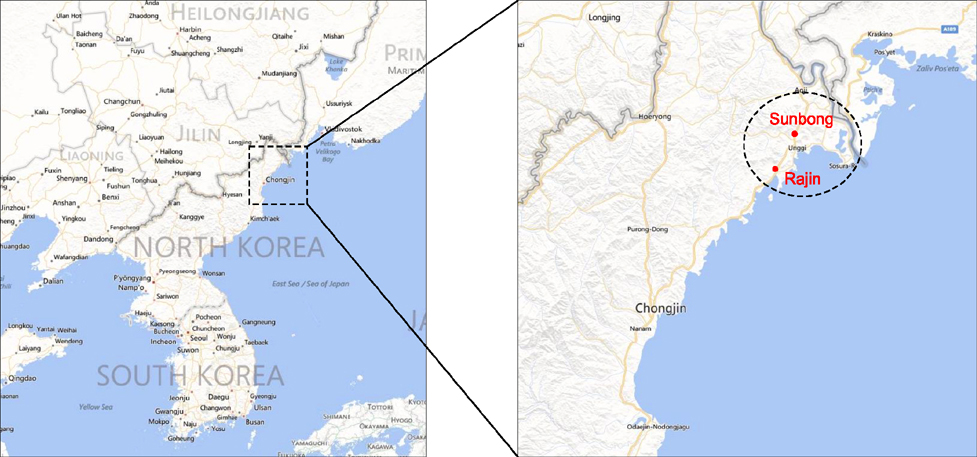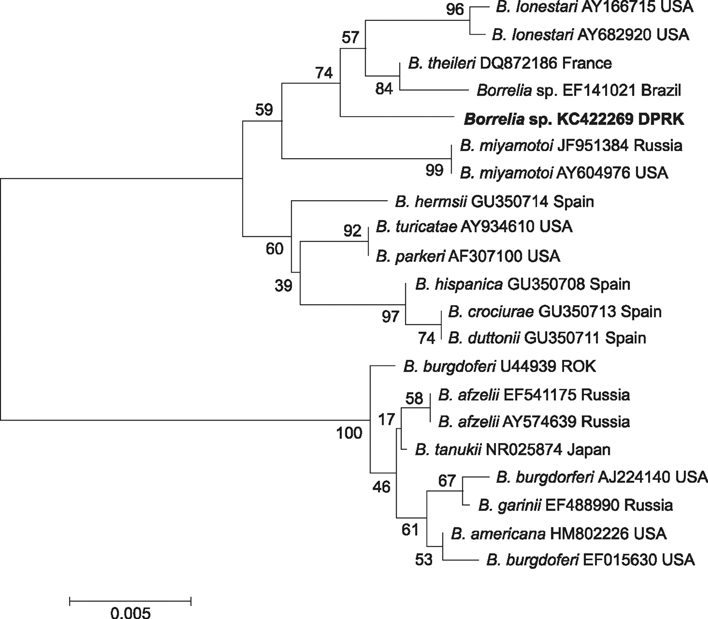J Vet Sci.
2016 Jun;17(2):207-216. 10.4142/jvs.2016.17.2.207.
Prevalence of Anaplasma, Bartonella and Borrelia Species in Haemaphysalis longicornis collected from goats in North Korea
- Affiliations
-
- 1Laboratory of Veterinary Internal Medicine, BK21 PLUS Program for Creative Veterinary Science Research, and Research Institute for Veterinary Science, College of Veterinary Medicine, Seoul National University, Seoul 08826, Korea. jschae@snu.ac.kr
- 2College of Veterinary Medicine, Auburn University, Auburn, AL 36849, USA.
- 3Department of Environmental Medical Biology, Yonsei University College of Medicine, Seoul 03722, Korea.
- KMID: 2413170
- DOI: http://doi.org/10.4142/jvs.2016.17.2.207
Abstract
- North Korea is located on the northern part of the Korean Peninsula in East Asia. While tick-borne pathogens of medical and veterinary importance have been reported from China and South Korea, they have not been reported from North Korea. To screen for zoonotic tick-borne pathogens in North Korea, ticks were collected from domestic goats. A total of 292 (27 nymph, 26 male, 239 female) Haemaphysalis (H.) longicornis were collected and assayed individually for selected tick-borne pathogens. A total of 77 (26.4%) were positive for Anaplasma bovis, followed by Bartonella (B.) grahamii (15, 5.1%), Anaplasma phagocytophilum (12, 4.1%), Bartonella henselae (10, 3.4%), and Borrelia spp. (3, 1.0%) based on 16S ribosomal RNA and ITS species-specific nested polymerase chain reaction. Using the groEL-based nested PCR, a total of 6 and 1 H. longicornis were positive for B. grahamii and B. henselae, respectively. All products were sequenced and demonstrated 100% identity and homology with previously reported sequences from other countries in GenBank. This is the first report of the detection of tick-borne pathogens in the North Korea and suggests that farm animals may act as reservoirs for zoonotic tick-borne pathogens.
Keyword
MeSH Terms
-
Anaplasma/isolation & purification
Anaplasmosis/*epidemiology/parasitology
Animals
Bartonella/isolation & purification
Bartonella Infections/epidemiology/microbiology/*veterinary
Borrelia/isolation & purification
Borrelia Infections/epidemiology/microbiology/*veterinary
Democratic People's Republic of Korea/epidemiology
Goat Diseases/*epidemiology/microbiology/parasitology
Goats
Ixodidae/*microbiology/*physiology
Phylogeny
Prevalence
Sequence Analysis, DNA/veterinary
Tick Infestations/parasitology/*veterinary
Figure
Reference
-
1. Barlough JE, Madigan JE, Derock E, Bigornia L. Nested polymerase chain reaction for detection of Ehrlichia equi genomic DNA in horses and ticks (Ixodes pacificus). Vet Parasitol. 1996; 63:319–329.
Article2. Biesiada G, Czepiel J, Leśniak MR, Garlicki A, Mach T. Lyme disease: review. Arch Med Sci. 2012; 8:978–982.3. Billeter SA, Levy MG, Chomel BB, Breitschwerdt EB. Vector transmission of Bartonella species with emphasis on the potential for tick transmission. Med Vet Entomol. 2008; 22:1–15.
Article4. Chae JS, Yu DH, Shringi S, Klein TA, Kim HC, Chong ST, Lee IY, Foley J. Microbial pathogens in ticks, rodents and a shrew in northern Gyeonggi-do near the DMZ, Korea. J Vet Sci. 2008; 9:285–293.
Article5. Chomel BB, Boulouis HJ, Maruyama S, Breitschwerdt EB. Bartonella spp. in pets and effect on human health. Emerg Infect Dis. 2006; 12:389–394.6. Chong ST, Kim HC, Lee IY, Kollars TM Jr, Sancho AR, Sames WJ, Chae JS, Klein TA. Seasonal distribution of ticks in four habitats near the demilitarized zone, Gyeonggi-do (province), Republic of Korea. Korean J Parasitol. 2013; 51:319–325.
Article7. Colwell DD, Dantas-Torres F, Otranto D. Vector-borne parasitic zoonoses: emerging scenarios and new perspectives. Vet Parasitol. 2011; 182:14–21.
Article8. Cotté V, Bonnet S, Le Rhun D, Le Naour E, Chauvin A, Boulouis HJ, Lecuelle B, Lilin T, Vayssier-Taussat M. Transmission of Bartonella henselae by Ixodes ricinus . Emerg Infect Dis. 2008; 14:1074–1080.9. Doan HTT, Hoh JH, Choe SE, Yoo MS, Kim YH, Reddy KE, Quyen DV, Nguyen LTK, Nguyen TTD, Kweon CH, Jung SC, Chang KY, Kang SW. Molecular detection and phylogenetic analysis of Anaplasma bovis from Haemaphysalis longicornis feeding on grazing cattle in Korea. Vet Parasitol. 2013; 196:478–481.
Article10. Dumler JS. The biological basis of severe outcomes in Anaplasma phagocytophilum infection. FEMS Immunol Med Microbiol. 2012; 64:13–20.
Article11. Harrus S, Perlman-Avrahami A, Mumcuoglu KY, Morick D, Eyal O, Baneth G. Molecular detection of Ehrlichia canis, Anaplasma bovis, Anaplasma platys, Candidatus Midichloria mitochondrii, and Babesia canis vogeli in ticks from Israel. Clin Microbiol Infect. 2011; 17:459–463.
Article12. Higgins JA, Radulovic S, Jaworski DC, Azad AF. Acquisition of the cat scratch disease agent Bartonella henselae by cat fleas (Siphonaptera: Pulicidae). J Med Entomol. 1996; 33:490–495.
Article13. Ishiguro F, Takada N, Masuzawa T, Fukui T. Prevalence of Lyme disease Borrelia spp. in ticks from migratory birds on the Japanese mainland. Appl Environ Microbiol. 2000; 66:982–986.
Article14. Jilintai , Seino N, Hayakawa D, Suzuki M, Hata H, Kondo S, Matsumoto K, Yokoyama N, Inokuma H. Molecular survey of Anaplasma bovis and Anaplasma phagocytophilum infection in cattle in a pastureland where sika deer appear in Hokkaido, Japan. Jpn J Infect Dis. 2009; 62:73–75.15. Kang JG, Kim HC, Choi CY, Nam HY, Chae HY, Chong ST, Klein TA, Ko S, Chae JS. Molecular detection of Anaplasma, Bartonella, and Borrelia species in ticks collected from migratory birds from Hong-do Island, Republic of Korea. Vector Borne Zoonotic Dis. 2013; 13:215–225.
Article16. Kang JG, Ko S, Kim YJ, Yang HJ, Lee H, Shin NS, Choi KS, Chae JS. New genetic variants of Anaplasma phagocytophilum and Anaplasma bovis from Korean water deer (Hydropotes inermis argyropus). Vector Borne Zoonotic Dis. 2011; 11:929–938.
Article17. Kang SW, Doan HTT, Choe SE, Noh JH, Yoo MS, Reddy KE, Kim YH, Kweon CH, Jung SC, Chang KY. Molecular investigation of tick-borne pathogens in ticks from grazing cattle in Korea. Parasitol Int. 2013; 62:276–282.
Article18. Kim CM, Yi YH, Yu DH, Lee MJ, Cho MR, Desai AR, Shringi S, Klein TA, Kim HC, Song JW, Baek LJ, Chong ST, O'Guinn ML, Lee JS, Lee IY, Park JH, Foley J, Chae JS. Tick-borne rickettsial pathogens in ticks and small mammals in Korea. Appl Environ Microbiol. 2006; 72:5766–5776.
Article19. Ko S, Kim SJ, Kang JG, Won S, Lee H, Shin NS, Choi KS, Youn HY, Chae JS. Molecular detection of Bartonella grahamii and B. schoenbuchensis-related species in Korean water deer (Hydropotes inermis argyropus). Vector Borne Zoonotic Dis. 2013; 13:415–418.
Article20. La Scola B, Raoult D. Culture of Bartonella quintana and Bartonella henselae from human samples: a 5-year experience (1993 to 1998). J Clin Microbiol. 1999; 37:1899–1095.
Article21. Larkin MA, Blackshields G, Brown NP, Chenna R, McGettigan PA, McWilliam H, Valentin F, Wallace IM, Wilm A, Lopez R, Thompson JD, Gibson TJ, Higgins DG. Clustal W and Clustal X version 2.0. Bioinformatics. 2007; 23:2947–2948.
Article22. Lee MJ, Chae JS. Molecular detection of Ehrlichia chaffeensis and Anaplasma bovis in the salivary glands from Haemaphysalis longicornis ticks. Vector Borne Zoonotic Dis. 2010; 10:411–413.23. Lee SH, Kim BJ, Kim JH, Park KH, Yeo SJ, Kim SJ, Kook YH. Characterization of Borrelia burgdorferi strains isolated from Korea by 16S rDNA sequence analysis and PCR-RFLP analysis of rrf (5S)-rrl (23S) intergenic spacer amplicons. Int J Syst Evol Microbiol. 2000; 50:857–863.
Article24. Liu S, Yuan C, Cui YF, Li BX, Wu LJ, Liu Y. Investigation of Borrelia spp. in ticks (Acari: Ixodidae) at the border crossings between China and Russia in Heilongjiang Province, China. Asian Pac J Trop Med. 2012; 5:459–464.
Article25. Moon S, Hong Y, Hwang KJ, Kim S, Eom J, Kwon D, Park JH, Youn SK, Sohn A. Epidemiological features and clinical manifestations of Lyme borreliosis in Korea during the period 2005-2012. Jpn J Infect Dis. 2015; 68:1–4.
Article26. Nair AS, Ravindran R, Lakshmanan B, Sreekumar C, Kumar SS, Raju R, Tresamol PV, Vimalkumar MB, Saseendranath MR. Bovine carriers of Anaplasma marginale and Anaplasma bovis in South India. Trop Biomed. 2013; 30:105–112.27. Nicholson WL, Allen KE, McQuiston JH, Breitschwerdt EB, Little SE. The increasing recognition of rickettsial pathogens in dogs and people. Trends Parasitol. 2010; 26:205–212.
Article28. Oh JY, Moon BC, Bae BK, Shin EH, Ko YH, Kim YJ, Park YH, Chae JS. Genetic identification and phylogenetic analysis of Anaplasma and Ehrlichia species in Haemaphysalis longicornis collected from Jeju island, Korea. J Bacteriol Virol. 2009; 39:257–267.
Article29. Park HS, Lee JH, Jeong EJ, Koh SE, Park TK, Jang WJ, Park KH, Kim BJ, Kook YH, Lee SH. Evaluation of groEL gene analysis for identification of Borrelia burgdorferi sensu lato. J Clin Microbiol. 2004; 42:1270–1273.
Article30. Park KH, Lee SH, Won WJ, Jang WJ, Chang WH. Isolation of Borrelia burgdorferi, the causative agent of Lyme disease, from Ixodes ticks in Korea. J Korean Soc Microbiol. 1992; 27:307–312.31. Rymaszewska A, Grenda S. Bacteria of the genus Anaplasma – characteristics of Anaplasma and their vectors: a review. Vet Med (Praha). 2008; 53:573–584.
Article32. Salkeld DJ, Lane RS. Community ecology and disease risk: lizards, squirrels, and the Lyme disease spirochete in California, USA. Ecology. 2010; 91:293–298.
Article33. Seki N, Sasaki T, Sawabe K, Sasaki T, Matsuoka M, Arakawa Y, Marui E, Kobayashi M. Epidemiological studies on Bartonella quintana infections among homeless people in Tokyo, Japan. Jpn J Infect Dis. 2006; 59:31–35.34. Sun J, Liu Q, Lu L, Ding G, Guo J, Fu G, Zhang J, Meng F, Wu H, Song X, Ren D, Li D, Guo Y, Wang J, Li G, Liu J, Lin H. Coinfection with four genera of bacteria (Borrelia, Bartonella, Anaplasma, and Ehrlichia) in Haemaphysalis longicornis and Ixodes sinensis ticks from China. Vector Borne Zoonotic Dis. 2008; 8:791–795.35. Tamura K, Dudley J, Nei M, Kumar S. MEGA4: Molecular Evolutionary Genetics Analysis (MEGA) software version 4.0. Mol Biol Evol. 2007; 24:1596–1599.
Article36. Tsai YL, Chang CC, Chuang ST, Chomel BB. Bartonella species and their ectoparasites: selective host adaptation or strain selection between the vector and the mammalian host? Comp Immunol Microbiol Infect Dis. 2011; 34:299–314.
Article37. Xia Z, Yu D, Mao J, Zhang Z, Yu J. The occurrence of Dirofilaria immitis, Borrelia burgdorferi, Ehrlichia canis and Anaplasma phagocytophium in dogs in China. J Helminthol. 2012; 86:185–189.
Article38. Yamaguti N, Tipton VJ, Keegan HL, Toshioka S. Ticks of Japan, Korea and the Ryukyu Islands. Sci Bull Biol Ser. 1971; 15:1–227.39. Yoshii K, Mottate K, Omori-Urabe Y, Chiba Y, Seto T, Sanada T, Maeda J, Obara M, Ando S, Ito N, Sugiyama M, Sato H, Fukushima H, Kariwa H, Takashima I. Epizootiological study of tick-borne encephalitis virus infection in Japan. J Vet Med Sci. 2011; 73:409–412.
Article40. Zeaiter Z, Fournier PE, Ogata H, Raoult D. Phylogenetic classification of Bartonella species by comparing groEL sequences. Int J Syst Evol Microbiol. 2002; 52:165–171.
Article41. Zhang L, Liu H, Xu B, Lu Q, Li L, Chang L, Zhang X, Fan D, Li G, Jin Y, Cui F, Shi Y, Li W, Xu J, Yu XJ. Anaplasma phagocytophilum infection in domestic animals in ten provinces/cities of China. Am J Trop Med Hyg. 2012; 87:185–189.
Article
- Full Text Links
- Actions
-
Cited
- CITED
-
- Close
- Share
- Similar articles
-
- Genetic Identification and Phylogenetic Analysis of Anaplasma and Ehrlichia Species in Haemaphysalis longicornis Collected from Jeju Island, Korea
- Epidemiological Investigation of Tick Species from Near Domestic Animal Farms and Cattle, Goat, and Wild Boar in Korea
- Molecular and phylogenetic analysis of Anaplasma spp. in sheep and goats from six provinces of China
- Status of Haemaphysalis tick infestation in domestic ruminants in Iran
- Prevalence of Anaplasma and Bartonella spp. in Ticks Collected from Korean Water Deer (Hydropotes inermis argyropus)







